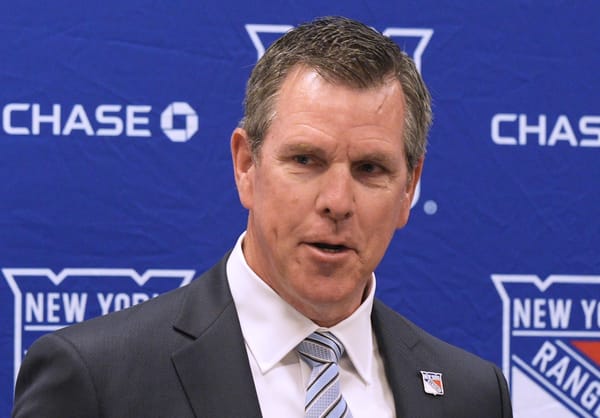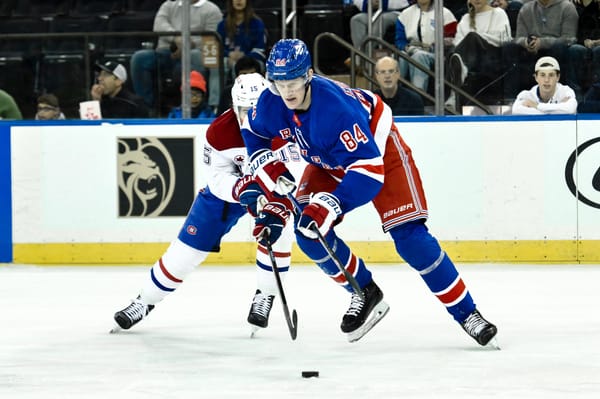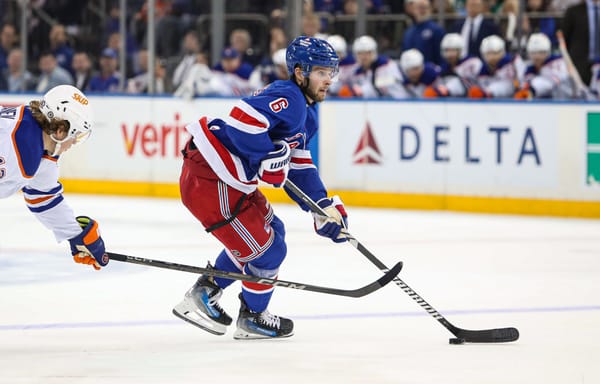Relitigating Past Rangers With Modern Data
Do past opinions on former Rangers hold up under the lens of new information?
Hockey analytics still has not quite caught up to that in other major North American sports, but the data available, especially in the public sector, is miles ahead of where it was 15, 10, and even just a few years ago. That data not only gives fans, media, and teams alike more perspective on the performances of players, but it also allows for a reinvestigation of the past.
Whose reputations hold up? Who got unfairly criticized? What mistakes in evaluation could have been prevented with that type of information available? I decided to take a look at a handful of players from prior Rangers’ seasons to see what this new data tells us about what we may not have known back then.
Tom Poti
If one was to build a Mount Rushmore for players who defined the 1997-2004 “Dark Ages” for the New York Rangers, defenseman Tom Poti would be a strong contender to make the cut. The term “whipping boy” has recently lost most of its meaning as apologists use it to describe underperforming players who receive lots of individual criticism. Poti, in contrast, firmly fit the title. He was routinely razzed when he touched the puck. In fact, Madison Square Garden mercilessly booed him following the PA announcement of his go-ahead goal against the Pittsburgh Penguins on March 7th, 2004. Say what you want about persistent criticisms of Tanner Glass, Dan Girardi, or Marc Staal, but that would never in a million years have happened to them. Poti was a true whipping boy.
There were multiple contributing factors to this perception of Poti. First, fans were out of patience on the whole following so many years of misery, and any potential target of mercy was going to receive full wrath.
Most of his tenure as a Ranger occurred prior to the 2004-05 lockout, meaning that old-school beliefs about hockey, and particularly defensemen, dominated the discourse. Poti played a very timid style and typically shied away from throwing hits or any other physical plays. His 6’3, 200-pound frame made this particularly stand out. The perception was he was “soft” and indifferent. It didn’t help that, to acquire Poti from the Edmonton Oilers in 2002, the Rangers traded Mike York, a fan favorite known for his hustle.
Yet if you looked at stats available even at the time, something doesn’t fully add up. Poti posted eight points in 11 games in 2002 following the trade, then produced back-to-back 10-goal seasons, tallying 72 points in 147 games. All while playing on terrible teams in a hostile environment during the peak of hockey’s Dead-Puck Era. Even if Poti’s defensive play was as horrible as advertised, it’s hard to imagine his offensive performance did not make up for that as it does for Tony DeAngelo.
Unfortunately, a lot of the data used in modern analytical analysis only goes as far back as the 2007-2008 season. So we can’t use that to judge Poti’s Rangers tenure, which ended in 2006, specifically.
The remainder of his NHL career does offer some clues, though. From 2007-08 until 2010-11, Poti typically played top-pairing minutes for some very good Washington Capitals teams. His scoring numbers went down, but per Evolving Hockey, Poti was on the ice at five-on-five for 146.3 expected goals for versus 110.0 expected goals against. Even after adjusting the data to account for other factors, including some elite talent which he assuredly benefitted alongside, Poti comes out looking good. Poti ranks 44th among all defensemen by Goals Above Replacement during that four-year span. Particularly surprising is that his defensive impact was positive, as Evolving Wild estimates his defensive impact was 7.9 goals better than replacement value.
That Poti played well elsewhere does not mean that he necessarily had to have played well with the Rangers as well. It’s also possible that revolutionary changes to the game post-lockout suited his playing style better. However, common sense and knowledge of aging curves would indicate that if this is how he performed in his 30s towards the end of his career, then he likely was an even better player during his mid-20s years as a New York Ranger.
There is no smoking gun, but there is a lot of circumstantial evidence that indicates that Tom Poti was a much better player than he ever got credit for as a New York Ranger.
Nigel Dawes
In hindsight, it’s hard to believe Nigel Dawes was not viewed as a high-end prospect. In the last 20 WHL seasons only Evander Kane and Joffrey Lupul scored more goals during a draft season than Dawes, who posted 47 in 72 games for the Kootenay Ice in 2003. It’s remarkable that he fell to round five with that kind of output, and though he sort of plateaued the following two WHL seasons, he continued a torrid scoring rate with the AHL’s Hartford Wolf Pack for parts of three seasons.
Dawes never played a full season with the Rangers. He was demoted at multiple points throughout the 2007-2008 season and was traded to the Coyotes at the 2009 deadline. Nevertheless, in his time wearing the Blueshirt he played 113 games over those two seasons and was, at worst, decent. His 24 goals and 26 assists translate to 17 goals and 36 points over an 82-game season, which is uninspiring but certainly NHL-caliber. What’s more, Dawes was often at the bottom of the roster, averaging in the range of 13 minutes per game. How many points could he have produced with more consistent playing time?
The modern data puts Dawes in great light. Per Evolving Hockey, he led all Rangers in total Goals Above Replacement (14.4) over those two seasons even despite so many games missed.
There were some valid criticisms of his game. He was listed at 5’8 and didn’t skate particularly well, especially given that size. His defensive game was lacking.
But Dawes was also a victim of an era that wasn’t ready for a player like him. At the time, the top-two lines were your offensive weapons, and your bottom-six was reserved for the players who did the other things. He wasn’t an explosive enough offensive contributor to justify the top-six role, and his inability to contribute as a checker and penalty killer meant he had a tough time finding an identity.
Roster dynamics have since changed with teams now willing to employ offensive drivers on at least the third-line. Beyond putting up points, Dawes did, indeed, drive play and create offense. Maybe Dawes’ game that dominated lower levels of hockey didn’t fully translate to the NHL, but the numbers back up that he was still an NHL-caliber player and certainly deserved a role over many far worse depth forwards the Rangers used during that era.
Dawes struggled heavily with Arizona before another solid season in Calgary, then short stints in Atlanta and Montreal. He has since made a name for himself as one of the best players in KHL (Russia) history. It’s fair to wonder if, with modern data, NHL teams may have given Dawes a better chance to stick.
P.A. Parenteau
Parenteau fell into a similar camp as Dawes. He was a high-end scorer at the junior level but fell to the ninth (!!!) round because of concerns about his size, dynamic ability, and game away from the puck. Even as he approached point-per-game status in the AHL, he struggled to earn more than five games with the Chicago Blackhawks.
The Rangers acquired him as a 24-year-old in 2007 to bolster AHL Hartford, and after absolutely tearing up the league for parts of two seasons he finally got his chance in 2009.
Parenteau produced three goals and five assists over 22 games split over two stints. The production didn’t justify the other perceived warts in his game. Specifically, the Rangers were getting scored on quite often when he was on the ice.
Parenteau left the team at the end of the season and signed with the rival New York Islanders. As a team with a shoestring budget and a lack of talent, the Islanders created the perfect opportunity for Parenteau to get a long look on a top NHL line. He surprised with a 20-goal, 53-point season and continued to produce for six more seasons for various NHL teams. Following his departure from the Rangers, Parenteau totaled 111 goals and 176 assists over 464 games, or an average roughly 20 goals and 51 points over 82 games. Pretty good for a player who didn’t truly make the big leagues until he was 27.
However, now available analytical data may have provided Parenteau a lifeline had the team known about it then. Although the Rangers’ five-on-five goals against average with Parenteau on the ice was 3.29, the expected goals against average was 2.33. In other words, he was extremely unlucky. One would have to go back to the tape to figure out whether that was the result of fluke bounces, elite shots, or bad goaltending.
That does not explain the mediocre offensive production and it’s possible that Parenteau never would have found it in then-head coach John Tortorela’s system. And, of course, statistics never tell the full story. Nevertheless, it’s fair to wonder if the Rangers would have given Parenteau more runway to get going offensively had they known that he was, at least statistically, actually one of their better suppressors of scoring chances against.
Michael Sauer
When Michael Sauer suffered a serious concussion following a hit by Dion Phaneuf in December of 2011, it was considered a major blow to a Rangers’ season in which they were poised to contend. Although the team’s staunch defense was highlighted by the top pairing of Ryan McDonagh and Dan Girardi, everyone perceived Sauer as the quiet linchpin. At 6’3 and 213 pounds, Sauer was a strong defender who earned a reputation for closing gaps in the neutral zone, punishing puck carriers, and cleaning out the slot area.
He was not known for any real offensive acumen. Even at lower levels Sauer barely produced to the point that his three-goal, 15-point NHL season in 2010-11 could be classified as a pleasant surprise.
If you’re looking for the type of player that modern data comes down hardest on, it’s usually the exact type of player that Sauer was. The kind of defender who contributes nothing offensively and who gets stuck in his own end often. Very few NHL defensemen with that skillset truly live up to their perceived value.
And yet.
Per Evolving Hockey, during the 2010-11 and 2011-12 seasons, Sauer ranked 13th among all defensemen in Defensive Goals Above Replacement. That’s incredibly good on its own but becomes even more remarkable knowing that Sauer played just 19 games in 2011-12. If you turn it into a rate stat (minimum 1000 minutes played), Sauer ranks third.
Here is how he compares over those two seasons to Willie Mitchell, a similar type of defenseman who was integral to the Los Angeles’ Kings 2012 Cup run. You’ll note that Sauer was a major suppressor of expected goals against.
First and foremost, the impact the concussion has had on Sauer’s life and career is a tragedy. In terms of the Rangers’ hockey aspirations, the data confirms that his loss was a huge blow. One remembers how uncomfortable Head Coach John Tortorellla was with using his depth defenseman during the 2012 playoffs, with the most infamous incident being Stu Bickel’s benching into triple overtime. What if Sauer had been available? What if he, then 24, could have been an integral member of the team for five-to-eight more years?
2017 Vegas Expansion Draft
It’s only fair to end this with an audit of one of my own stances.
The Rangers’ decisions for whom to protect for the 2017 Vegas Expansion Draft were pretty straightforward. Less obvious was which exposed player Vegas would snatch away. At the time I wrote that “Oscar Lindberg is the Rangers’ all-around most valuable asset vulnerable to the expansion draft.” He is, indeed, the player Vegas selected.
Although Antti Raanta and Michael Grabner have gone on to provide more value since, I still stand by my thinking at the time. Raanta was 28 and a year away from unrestricted free agency. He was never going to unseat Henrik Lundqvist, still “only” 35 at the time, and the Rangers had a strong pool of goaltending prospects. Grabner was turning 30 and also a year away from unrestricted free agency. Lindberg was just 25, produced decent offensive numbers despite often playing with sub-optimal linemates, and played the premium position of center.
Where I (and Vegas) inarguably did screw up was in the evaluation of Lindberg versus Jesper Fast. Hockey data analytics may have finally hit the mainstream in 2017, but statistics available then weren’t as sophisticated as what is available today. Lots of shot-quantity data was available, but the ability to account for shot quality, competition, coaching, and linemates was still in its relative infancy. Furthermore, all-encompassing statistics that serve to evaluate a player’s wholistic impact are better in 2020 than they were at the time of the expansion draft.
At the time I believed that Fast was no more than a 4th-line winger, which is the most replaceable position on an NHL roster. Evolving Hockey’s Goals Above Replacement data indicates that belief was demonstrably incorrect.
Evolving Hockey estimates that, over the two seasons prior to the Expansion Draft, Fast was worth 8 goals more than Lindberg. Lindberg rated as a perfectly good 4th-line center, but Fast was an elite third-liner.
Three years ago I believed Fast was easily the more disposable of the two. Had I known this kind of data then, I would like to think that I not only would have picked Fast as the most indispensable of the exposed players but may have even wondered if the Rangers should make a trade with Vegas to ensure he stayed in New York. Fortunately for the Rangers, Vegas also made the wrong decision.




